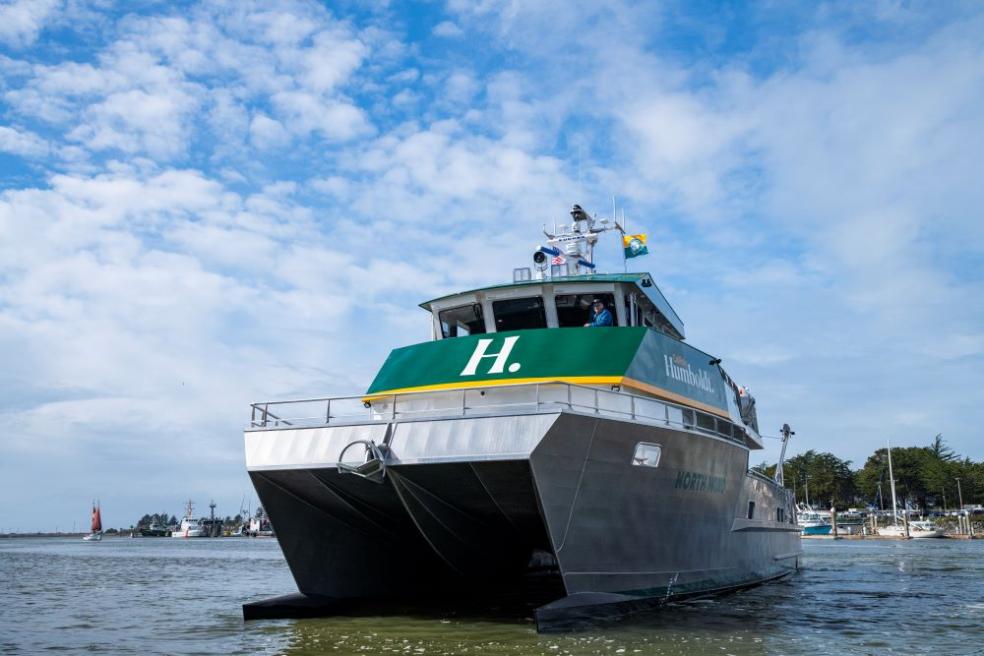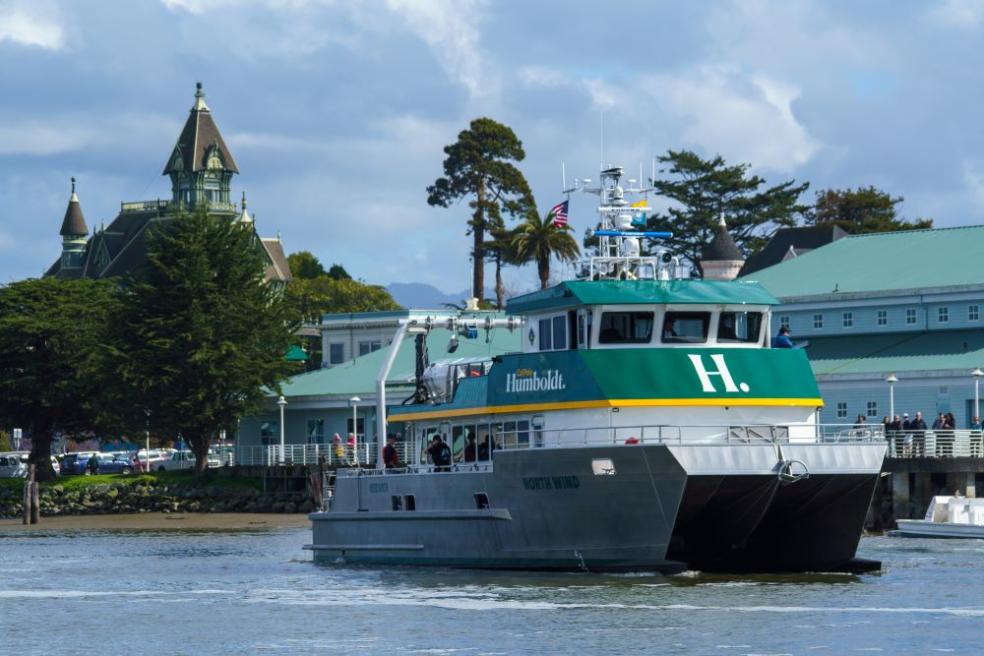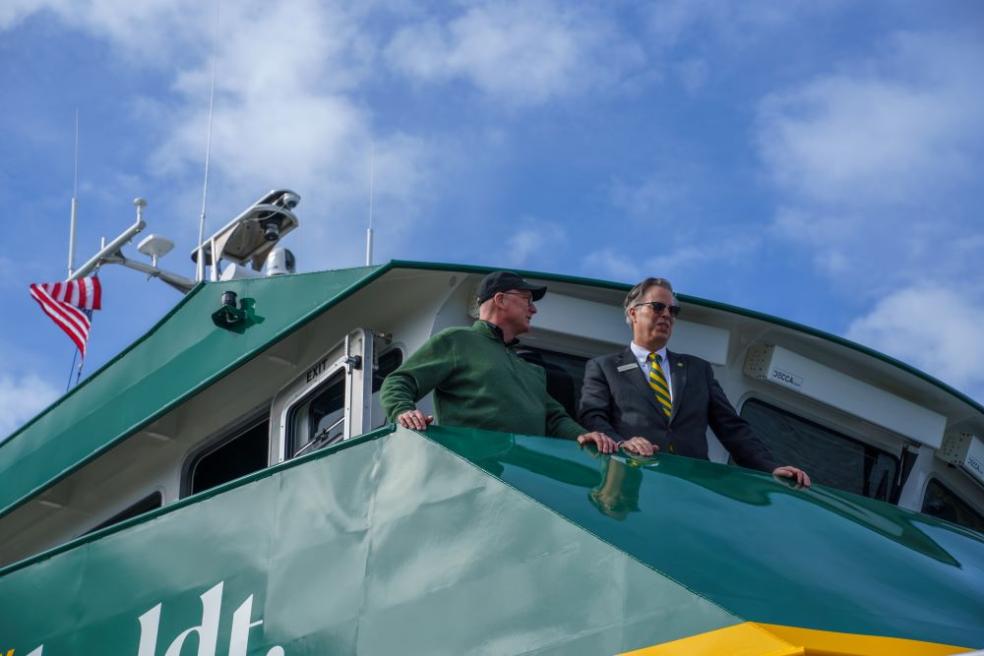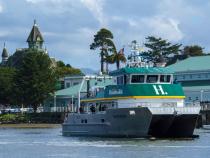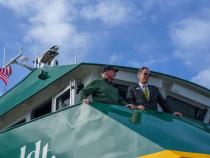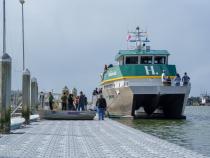“The R/V North Wind will expand our reach and capabilities in research and teaching throughout the North Coast,” Eric Riggs, Dean for the College of Natural Resources & Sciences says. “The new vessel adds capacity for addressing modern marine science, conservation, and economic issues that are directly relevant to communities and agencies in our region. It allows the University to be a full partner in the economic and scientific future of the offshore Blue Economy and allows our students to gain applicable skills and experiences in this growing area.”
During the homecoming event, remarks were made by Cal Poly Humboldt Interim President Michael Spagna, Dean Riggs, and former Associate Dean of Marine Operations and Director of the University’s Telonicher Marine Lab Rick Zechman. The R/V North Wind was officially christened by Jonae Calderon, a college analyst from the College of Natural Resources & Sciences at the University. R/V North Wind Capt. Jim Long invited attendees on a tour of the North Wind. Long is also the captain of the R/V Coral Sea, the University’s longtime marine research vessel, which will be retired next year.
The name of the new research vessel was selected through a collaborative process. In late October, the College of Natural Resources & Sciences conducted a broad community survey featuring nine proposed names. Nearly 2,000 students, staff, alumni, and community members participated in the survey, casting a total of 5,190 votes.
The chosen name reflects a significant physical process that characterizes this region. It drives the Pacific Current and contributes to ocean upwelling, which supports the mild climate and rich fisheries along the North Coast. Additionally, this process generates ocean swells that create the rugged coastline and bring a consistent flow of storms and moisture, leading to the temperate, wet climate that nourishes the forests and grasslands.
The R/V North Wind is a 78-foot by 28-foot custom-built aluminum catamaran, powered by twin 1100-horsepower Tier 4 engines, allowing it to travel at speeds of up to 24 knots. The vessel can carry up to 40 students, faculty, and crew on day trips and accommodate up to 14 people on multi-day research voyages. It is equipped with various hydraulic deck machinery capable of handling up to 5,000 pounds of oceanographic equipment and instrumentation.
The deck is designed to facilitate divers entering the water from two dive platforms at the stern. The vessel’s laboratory and pilot house will be equipped with state-of-the-art navigation and oceanographic electronics to measure the physical and biological features of the ocean bottom and water column.
This new $8.5 million research vessel is part of the state’s historic investment in Humboldt’s expansion as a polytechnic university.
The University has a long legacy of supporting both undergraduate and graduate academic experiences while promoting marine research. This commitment spans decades and includes programs and facilities such as the R/V Coral Sea, which the University purchased in 1998.
Since then, thousands of Cal Poly Humboldt students have gained hands-on experience in collecting and analyzing water and sediment samples, along with capturing fish from the deep ocean. They have also learned the fundamentals of seamanship and the requirements of working on a vessel at sea, according to Capt. Long
Compared to the Coral Sea, the new vessel, built by All American Marine, will be more fuel-efficient and capable of faster cruising speeds, allowing for explorations further offshore.
Research will continue on the R/V Coral Sea until it is phased out and retired from Cal Poly Humboldt by 2026 when the state’s new emissions standards take effect. These standards will require all five engines of the vessel to be replaced to operate in California. Although it has been well maintained, the Coral Sea is 50 years old and has surpassed the average 30-year lifespan of research vessels. For decades, it has supported both undergraduate and graduate educational programs, enabling thousands of students to learn seamanship basics while gathering and analyzing data on various aspects of marine life and sediment.
With a design that functions as both a laboratory and a floating classroom, the R/V North Wind will enhance the University’s ability to prepare students and train the next generation of marine scientists.
